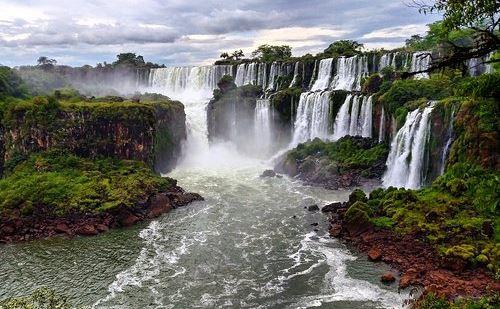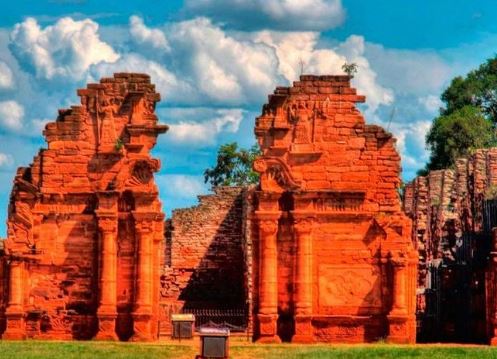Great rivers, waterfalls & ruins
Forests, rivers, waterfalls, swamps, Jesuit ruins...
When the nature becomes spectacle...
Forests, rivers, waterfalls, swamps, Jesuit ruins...
When the nature becomes spectacle...
 In the area that includes the provinces of Misiones, Corrientes, Entre Rios, Chaco and Formosa, there are different panoramas and climates that have their own enchantment that has dazzled in a certain sense, the sensitivity of travelers of all origins, becoming one of the tourist destinations most important in the world. Lush nature, reserves, natural parks, architecture in the Jesuit missions declared "Cultural Heritage of Humanity" by UNESCO, large rivers, impeccable hotel infrastructure, international airports and updated transport and communication systems, harmony and courtesy of its people, make the region the place where everyone would like to go at least once.
In the area that includes the provinces of Misiones, Corrientes, Entre Rios, Chaco and Formosa, there are different panoramas and climates that have their own enchantment that has dazzled in a certain sense, the sensitivity of travelers of all origins, becoming one of the tourist destinations most important in the world. Lush nature, reserves, natural parks, architecture in the Jesuit missions declared "Cultural Heritage of Humanity" by UNESCO, large rivers, impeccable hotel infrastructure, international airports and updated transport and communication systems, harmony and courtesy of its people, make the region the place where everyone would like to go at least once.
The Iguazu Falls ("Big Water" in the Guarani language) are located in the province of Misiones, in the north-east of the country, on the border with Paraguay and Brazil and included in the Iguazu National Park with its thousands of palm trees and orchids , and where toucans, parrots and parakeets coexist in harmony with monkeys, tapirs and jaguars. It was their roar, audible 15 km away, that led Alvar Nuñez Cabeza de Vaca to their discovery in 1541: 275 jumps, 50 to 80 meters high, for 2,700 metres. The origin was a volcanic eruption millions of years ago, following which the Iguazu river, unable to dig a bed for itself, began to flow on the basalt ground. In addition to the famous Garganta del Diablo, an 80 meter high water wall, there are other jumps (Bossetti, Alvar Cabeza de Vaca, etc.) that can be visited on foot along walkways, paths and viewpoints that allow you to observe them from a distance very close.
In just two hours by plane you can get from Buenos Aires to Posadas, capital of the province of Misiones on the bank of the Paranà river, where you can practice every type of water sport and is interesting for its museums with finds from the Guaranì Indians and the Palace del Matè, among others, including the botanical garden with tree species from the Misiones forest.
Oberà, the second city of the province whose name in the Guarani language means "she who shines" is surrounded by red earth roads, wild places, giant trees, nature reserves and aboriginal communities, ideal places to experience ecological adventures as well as stop in houses of countryside and visit tea and maté plantations.
Puerto Iguazù is a true international tourism hub, a strategic point between three borders (Argentina, Paraguay and Brazil) where you can buy artisanal products from the area. A few kilometers away is Wanda with its open-air deposit of semi-precious stones.
 The 300 km road between Posadas and the waterfalls is an enchanting journey through the jungle, with some interesting places to stop and visit, such as tea and maté plantations, a widely used local herb, precious mines and some ruins of the ancient Jesuit missions in San Ignacio Minì. This mission was built in the 17th century by the Guarani, the indigenous inhabitants of the area. Some of the reddish sand walls are 10 m high, the best preserved remains are the columns, galleries and entrance steps of the church. The decorations (floral motifs, angels and doves) were probably carved into the walls. San Ignacio Minì was burned in 1817 and what remained was swallowed up by the jungle. It was rediscovered in 1897 and today it can be visited every day from 7.30am to 6pm.
The 300 km road between Posadas and the waterfalls is an enchanting journey through the jungle, with some interesting places to stop and visit, such as tea and maté plantations, a widely used local herb, precious mines and some ruins of the ancient Jesuit missions in San Ignacio Minì. This mission was built in the 17th century by the Guarani, the indigenous inhabitants of the area. Some of the reddish sand walls are 10 m high, the best preserved remains are the columns, galleries and entrance steps of the church. The decorations (floral motifs, angels and doves) were probably carved into the walls. San Ignacio Minì was burned in 1817 and what remained was swallowed up by the jungle. It was rediscovered in 1897 and today it can be visited every day from 7.30am to 6pm.
Corrientes, located on the right bank of the Paranà river, is known worldwide for its fauna, particularly fish, for the Dorado fishing with its related international events, its carnival and the swampy areas of the Esteros del Iberà.
Chaco with its National Park of approximately 15,000 hectares with exuberant vegetation and fauna with turtles, yacarè, etc. The impenetrable forest with varied vegetation where the red and white "quebracho" reigns undisputed, with few passable roads.
The province of Entre Rìos, called the "green province" for its vegetation, is located between the Paranà and Uruguay rivers and together with the provinces of Corrientes and Misiones forms the Argentine region of Mesopotamia.
It can be visited in any season as it offers views, history and tradition and a strategic situation very close to the large Argentine cities. Hills, forests, river and two large natural parks characterize it: El Palmar and the Pre Delta with extraordinary variety of flora and fauna.
In Paranà, the capital, it is interesting to cross the Subfluvial Tunnel, which passing under the Paranà river unites this city with that of Santa Fè.
The province of Santa Fè, agricultural and industrial par excellence, attracts for its river, the Paranà, where on the islands there are enchanting places for recreation.
The rivers of the region are ideal places for practicing water sports, such as windsurfing, water skiing, canoeing, kayaking, etc. Fishing is one of the most practiced sports (surubì, pati, dorado, bagre and pescarè).
Rosario, an industrial and commercial city, is famous for the Flag Monument, Independence Park and its museums.